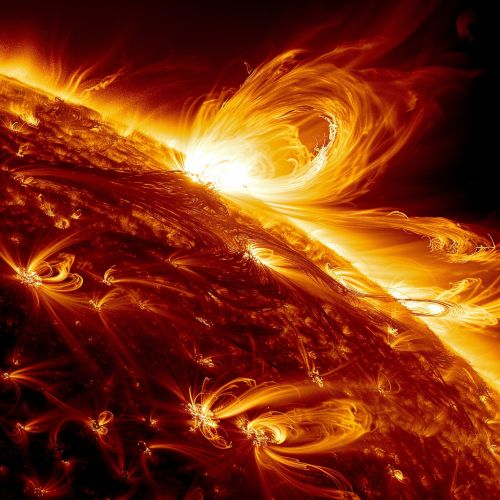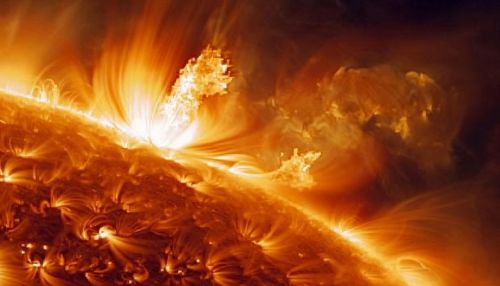Solar Flare
Introduction
A solar flare is a sudden flash of increased brightness on the sun, usually observed near its surface and in close proximity to a sunspot group. Powerful flares are often, but not always, accompanied by a coronal mass ejection. The flare ejects clouds of electrons, ions, and atoms through the corona into space. These clouds typically reach Earth a day or two after the event.


Classification
Solar flares are classified as A, B, C, M or X according to the peak flux (in watts per square meter, W/m^2) of 100 to 200 picometer X-rays near Earth, as measured on the GOES spacecraft. Each class has a peak flux ten times greater than the preceding one, with X class flares having a peak flux of order 10^-4 W/m^2. Within a class there is a linear scale from 1 to 9.n (apart from X), so an X2 flare is twice as powerful as an X1 flare, and is four times more powerful than an M5 flare.
Causes
Solar flares occur in a power-law spectrum of magnitudes; an energy release of typically 1 × 10^20 joules of energy suffices to produce a clearly observable event, while a major event can emit up to 1 × 10^25 joules. Flares are powered by the sudden (timescales of minutes to tens of minutes) release of magnetic energy stored in the corona. The same energy releases may produce coronal mass ejections (CME), although the relation between CMEs and flares is still not well established.
Impact on Earth
Solar flares strongly influence the local space weather in the vicinity of the Earth. They can produce streams of highly energetic particles in the solar wind, known as a solar particle event, or "coronal mass ejection" (CME). These particles can impact the Earth's magnetosphere (see main article at geomagnetic storm), and present radiation hazards to spacecraft and astronauts. Additionally, massive solar flares are sometimes accompanied by coronal mass ejections (CMEs) which can trigger geomagnetic storms that have been known to disable satellites and knock out terrestrial electric power grids for extended periods of time.
Observations and Forecasting
The first solar flare recorded in astronomical literature was on September 1, 1859. Two scientists, Richard Carrington and Richard Hodgson, independently made the first observations of a solar flare. The event was visible to a naked eye (in white light), and produced stunning auroras down to tropical latitudes such as Cuba or Hawaii, and set telegraph systems on fire. The flare left a trace in Greenland ice in the form of nitrates and beryllium-10, which allow its strength to be measured today.
Modern observations of the Sun are primarily carried out through the use of space telescopes. Among the most important modern solar observatories include the Solar and Heliospheric Observatory (SOHO), the Solar Dynamics Observatory (SDO), and the Hinode mission.
